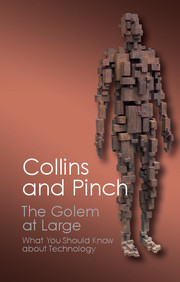Book contents
- Frontmatter
- Dedication
- Contents
- Preface and acknowledgements
- Introduction: the technological golem
- 1 A clean kill?: the role of Patriot in the Gulf War
- 2 The naked launch: assigning blame for the Challenger explosion
- 3 Crash!: nuclear fuel flasks and anti-misting kerosene on trial
- 4 The world according to Gold: disputes about the origins of oil
- 5 Tidings of comfort and joy: Seven Wise Men and the science of economics
- 6 The science of the lambs: Chernobyl and the Cumbrian sheepfarmers
- 7 ACTing UP: AIDS cures and lay expertise
- Conclusion: the golem goes to work
- References and further reading
- Index
Conclusion: the golem goes to work
Published online by Cambridge University Press: 05 June 2014
- Frontmatter
- Dedication
- Contents
- Preface and acknowledgements
- Introduction: the technological golem
- 1 A clean kill?: the role of Patriot in the Gulf War
- 2 The naked launch: assigning blame for the Challenger explosion
- 3 Crash!: nuclear fuel flasks and anti-misting kerosene on trial
- 4 The world according to Gold: disputes about the origins of oil
- 5 Tidings of comfort and joy: Seven Wise Men and the science of economics
- 6 The science of the lambs: Chernobyl and the Cumbrian sheepfarmers
- 7 ACTing UP: AIDS cures and lay expertise
- Conclusion: the golem goes to work
- References and further reading
- Index
Summary
Promises delivered
The conclusion of The Golem, the first volume in this series, argued that the book had wide significance where science touched on matters of public concern. Here we deliver on that promise.
The chapter on the Challenger explosion shows the way that human error is taken to account for technological failure and shows how unfair it is to assign blame to individuals when the uncertainties are endemic to the system as a whole.
The Challenger enquiry is one case among many that reveals that when the public views the fruits of science from a distance the picture is not just simplified but significantly distorted. Nobel laureate Richard Feynman demonstrated on TV that when a piece of rubber O-ring was placed in a glass of iced water it lost resilience. This was at best trivial – the effect of low temperature on rubberwas alreadywell understood by the engineers. At worst it was a dangerously misleading charade – an acting-out of the most naive model of scientific analysis. The crucial question was not whether low temperature affected the O-rings but whether NASA had reason to believe this would cause them to fail. Feynman gives the impression that doubts can always be simply resolved by a scientist who is smart enough.
- Type
- Chapter
- Information
- The Golem at LargeWhat You Should Know about Technology, pp. 198 - 204Publisher: Cambridge University PressPrint publication year: 2014



